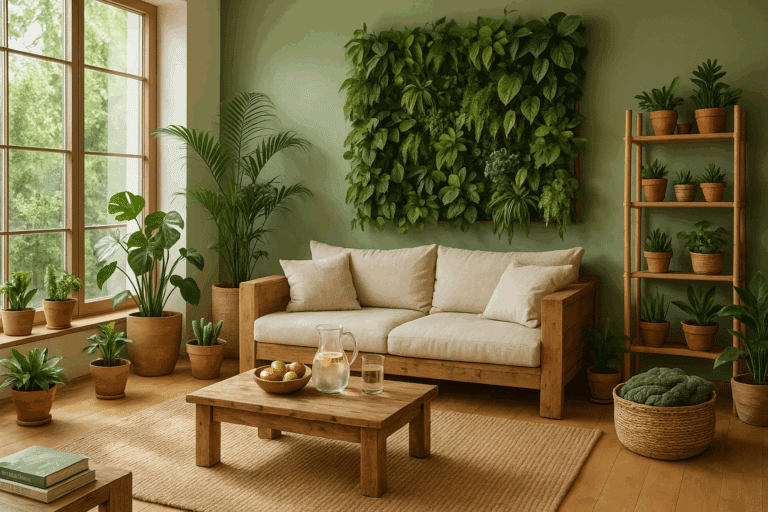The charm of rustic, vintage pieces cannot be understated, and one such enchanting piece is a salvaged ladder shelf. The ladder, often seen as a practical tool, takes on a new life when transformed into a versatile and elegant shelf. 🌱
This post is an exploration of the wondrous world of upcycled wood and the role it can play in shaping your space into a beautiful, eco-friendly haven. It’s about converting an ordinary ladder into a lively garden shelf and integrating it seamlessly into your decor. Imagine a structure, rich in history, adorned with lush green plants and blooming flowers, standing as an embodiment of rustic allure in your home. 🏡
The idea of upcycling has taken root in interior design in recent years, paving the way for innovative and sustainable solutions. A salvaged ladder shelf garden is not only a great conversation starter but also an excellent way to showcase your green thumb and interior design prowess.
Through the course of this discussion, we will delve into the process of transforming a salvaged ladder into a stunning garden shelf. This journey will take us through tips and tricks, design ideas, and the sheer joy of creating something beautiful from something that might have otherwise been discarded.💡
So, prepare to embark on a creative journey where old meets new, practical meets stylish, and charm meets simplicity. Discover how a salvaged ladder shelf garden can add a touch of rustic charm to your space and serve as a testament to your commitment to the environment. 🌍 Let’s transform, let’s upcycle!
From Waste to Wonder: A Practical Guide to Upcycling with a Ladder Shelf Garden
In today’s world, where environmental consciousness is becoming more than a trend—rather a necessity—people are actively seeking ways to live more sustainably. DIY enthusiasts, eco-conscious homeowners, and creative designers alike are turning toward the practice of upcycling. Upcycling breathes new life into old materials, transforming them into something useful, beautiful, and often even more valuable than their original form. It’s not just recycling—it’s a reinvention of purpose.
One of the most inspiring and functional applications of upcycling is the creation of a ladder shelf garden using salvaged materials, particularly an old wooden ladder. This project is not only a testament to environmental responsibility, but also a unique way to enhance your indoor or outdoor space with greenery, personality, and rustic charm.
Understanding the Concept of Upcycling
Upcycling is the process of reusing discarded materials in a way that creates a product of higher quality or value than the original. It is often confused with recycling, but while recycling breaks down materials to produce something new (often of lesser quality), upcycling maintains the integrity of the original object, giving it new function and life.
When you upcycle, you’re doing more than avoiding waste—you’re expressing creativity, saving money, and often preserving a piece of history. Every dent in an old ladder, every grain of reclaimed wood carries character that manufactured items lack. In this sense, upcycling is as much about storytelling as it is about sustainability.
Environmental Benefits of Upcycling
Reducing Landfill Waste
By using materials that would otherwise end up in landfills, upcycling contributes to waste reduction. According to the Environmental Protection Agency (EPA), millions of tons of wood waste are generated annually. Giving old furniture or wood pieces a second life helps reduce the volume of that waste.
Lowering Demand for New Resources
Upcycling limits the need for new raw materials. When you reuse wood, metal, or plastic, you reduce the demand for timber, minerals, and other finite natural resources. This means fewer trees cut, less mining, and fewer pollutants released into the environment.
Energy Efficiency
Producing new materials requires significant energy. Processing raw wood involves felling trees, transporting logs, and manufacturing lumber. Upcycling, by contrast, requires far less energy—often just a bit of sanding, sawing, and finishing.

Carbon Footprint Reduction
Upcycling helps cut down on greenhouse gas emissions by reducing the manufacturing and transportation of new goods. Plus, by introducing more plants into your living space—such as with a shelf garden—you’re literally contributing to carbon sequestration.
The Ladder Shelf Garden: A Beautiful Example of Upcycling
What is a Ladder Shelf Garden?
A ladder shelf garden is a repurposed ladder that has been transformed into a tiered plant stand or garden display. The rungs of the ladder serve as structural supports for shelves made from reclaimed wood, creating multiple levels for plant pots, herbs, succulents, or decorative garden accessories.
These gardens are versatile and can be placed indoors to brighten up a living room, in a kitchen for herbs, on a balcony, or in a backyard as a vertical gardening solution. They’re perfect for urban gardening, compact spaces, or anyone who loves a rustic or bohemian aesthetic.
Step-by-Step: How to Build a Ladder Shelf Garden
Step 1: Sourcing Your Materials
The heart of upcycling lies in finding the right materials. Visit flea markets, salvage yards, garage sales, or even your own garage or shed. Look for:
- An old wooden ladder: The ladder can be A-frame (freestanding) or a straight ladder that can lean against a wall or fence.
- Reclaimed wood: Old shelves, fence panels, or discarded pallets work great.
- Screws, bolts, nails: Reuse what you can, or opt for sustainable fasteners.
- Protective gear: Gloves, safety glasses, and a dust mask for working with old wood.
Keep an eye out for wood with unique grain patterns, paint remnants, or hardware still attached—these details add character.
Step 2: Preparing the Ladder
Before beginning construction, the ladder needs to be cleaned and prepped.
- Clean thoroughly: Use a damp cloth, gentle detergent, or vinegar to remove dirt, cobwebs, and grease.
- Inspect for damage: Check for rot, weak joints, or splintering. You want your structure to be sturdy and safe.
- Sand the wood: Use medium- to fine-grit sandpaper to remove old finishes, smooth rough edges, and prep for staining or painting.
- Apply a finish: For indoor use, a clear polyurethane or wax finish will suffice. For outdoor settings, use weatherproof paint, marine-grade varnish, or tung oil for protection.
This step enhances longevity and aesthetics, preserving the natural beauty of the wood while making it safe for handling and plant exposure.
Step 3: Adding the Shelves
Now it’s time to transform the ladder into a functional garden:
- Measure spacing: Decide the height and depth of each shelf. Use a level to mark even lines between rungs.
- Cut shelves to fit: Use reclaimed wood to create horizontal platforms that will rest across the ladder steps.
- Attach the shelves: You can screw shelves directly into the rungs or rest them on top if the fit is snug. For leaning ladders, add brackets to support the outer edges.
Pro Tip: Leave small gaps between wood slats to allow drainage if placing pots directly on the shelf.
Design Tips for Your Ladder Shelf Garden
Choosing the Right Plants
Selecting a variety of plants adds dimension and vibrancy:
- Herbs (for kitchens): Basil, thyme, mint, and oregano are practical and fragrant.
- Succulents: Low maintenance and come in a variety of textures and colors.
- Trailing Plants: Ivy, pothos, or string-of-pearls add cascading elegance.
- Seasonal Blooms: Rotate marigolds, pansies, or tulips by season.
- Edible Greens: Lettuce or spinach for a small-scale urban garden.
Group plants with similar care needs to ensure consistent watering and lighting.
Creative Display Ideas
Incorporate decorative items for added charm:
- Clay pots with hand-painted labels
- Upcycled mason jars as planters
- Mini lanterns, fairy lights, or solar-powered lights
- Vintage watering cans or garden tools for added character
Color-code your plants or accessories based on themes—spring pastels, autumn tones, or monochrome elegance.
Positioning Your Shelf Garden
Consider the following when deciding where to place your garden:
- Sunlight Exposure: Ensure it receives the appropriate light for your chosen plants.
- Accessibility: Place it where watering, pruning, and replanting will be easy.
- Visibility: Position in a focal area to maximize its aesthetic impact—like by a window, entryway, or backyard path.
If indoors, place a tray underneath or use self-watering pots to protect flooring.
Maintaining Your Ladder Shelf Garden
Watering and Feeding
Each plant has its own water and nutrient needs. Use self-watering bulbs, set reminders, or create a simple irrigation system if your display is large. Apply compost tea or organic fertilizers monthly for extra nourishment.

Seasonal Adjustments
Just like any garden, your ladder shelf garden requires seasonal care:
- Spring/Summer: Refresh soil, introduce new blooms.
- Fall: Trim spent flowers, add hardier plants like mums.
- Winter (outdoor): Protect or move indoors; cover with burlap or frost cloth.
- Winter (indoor): Reduce watering, increase sunlight exposure.
Regular care ensures your display remains lush and vibrant all year round.
Conclusion: A Greener Home Starts with One Ladder
Upcycling a ladder into a shelf garden is more than a weekend DIY project—it’s a statement. A statement about creativity, sustainability, and the value of seeing beauty where others see waste. It’s about nurturing both plants and possibilities.
With thoughtful design, careful plant selection, and a touch of personal flair, your ladder shelf garden will not only enhance your space but also serve as a daily reminder of the impact small choices can make. In every repurposed rung and blossoming shelf, you’re growing more than plants—you’re growing a lifestyle.
Seasonal Adjustments
Just like any garden, your ladder shelf garden requires seasonal care:
- Spring/Summer: Refresh soil, introduce new blooms.
- Fall: Trim spent flowers, add hardier plants like mums.
- Winter (outdoor): Protect or move indoors; cover with burlap or frost cloth.
- Winter (indoor): Reduce watering, increase sunlight exposure.
Regular care ensures your display remains lush and vibrant all year round.
Conclusion: A Greener Home Starts with One Ladder
Upcycling a ladder into a shelf garden is more than a weekend DIY project—it’s a statement. A statement about creativity, sustainability, and the value of seeing beauty where others see waste. It’s about nurturing both plants and possibilities.
With thoughtful design, careful plant selection, and a touch of personal flair, your ladder shelf garden will not only enhance your space but also serve as a daily reminder of the impact small choices can make. In every repurposed rung and blossoming shelf, you’re growing more than plants—you’re growing a lifestyle.
Final Thoughts
Upcycling can breathe new life into old, unused objects, turning them into functional and aesthetic additions to your home or office. An upcycled ladder shelf garden, for example, is not just a trendy piece of furniture; it also plays a significant role in promoting sustainability and reducing waste. Furthermore, it provides an opportunity to exercise creativity and DIY skills, making it a rewarding project to undertake.
Remember, the concept of upcycling goes beyond mere waste reduction. It’s about creating something new and valuable from what was once considered waste. So, don’t limit yourself to just ladder shelf gardens – there’s a world of possibilities waiting to be explored.
Conclusion
In conclusion, a rustic ladder shelf garden made from upcycled wood is an effective way to instill a sense of rustic charm into your space. It not only allows you to display your plants and garden accessories with an aesthetic touch, but also promotes sustainability by repurposing salvaged wood.
The beauty of this project lies in its simplicity and versatility. It can be tailored to fit any room size, decor style, or personal preference. The rustic ladder shelf garden is not just a functional piece, but also a work of art that reflects your unique personality and creativity.
Furthermore, the upcycled wood used in this DIY project brings a hint of history and character, adding depth and interest to your space. The rustic charm exuded by the salvaged ladder shelf garden is indeed a beautiful contrast to the contemporary minimalist designs we often see nowadays.
Ultimately, by creating a salvaged ladder shelf garden, you’re not only transforming your space but also contributing to the environment by reducing waste. It’s a win-win solution that blends design and sustainability in perfect harmony.
In this era of conscious living, a rustic ladder shelf garden made from upcycled wood is indeed a wonderful addition to your home.



